#cassia cinnamon stick
Text
Cassia Cinnamon Sticks
Red Ape Cinnamon is the real deal. When you want the best quality Cassia Cinnamon sticks, turn to us for all your needs. We take pride in offering 100% pure and freshly harvested cassia cinnamon. Our product is tested for safety and quality by experts so that we can deliver a great taste every time. To order cinnamon sticks visit our website now.
0 notes
Text
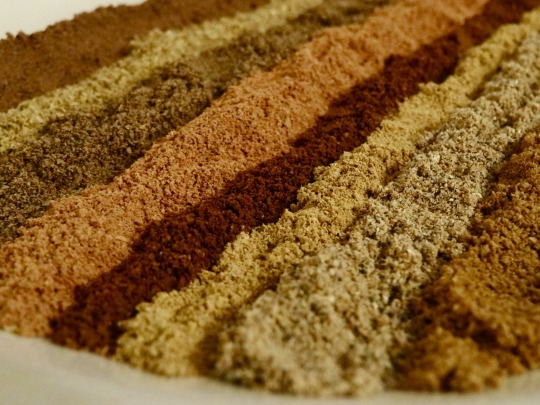
[ID: An extreme close-up of ground spices in various shades of brown and orange laid out in lines on a plate. End ID]
سبع بهارات فلسطينية / Seb'a baharat falastinia (Palestinian seven-spice)
Seb'a baharat is one of a few spice blends often referred to in English simply as “baharat” (the plural of Arabic بهار / bahar, “spice”). A warm, earthy blend, it is commonly used to season meat, fish, and poultry in the Levant, Eastern Arabia, and Egypt, where recipes differ from region to region and from person to person. Common ingredients include cumin, cardamom, black pepper, nutmeg, and cinnamon.
Palestinian versions of seb'a baharat are usually dominated by allspice, black pepper, and cinnamon, giving them a pungent and sweet head; nutmeg, cloves, and cardamom provide additional warmth, while cumin and coriander often round out the blend with earthiness and a hint of florality. Ginger is also an occasional inclusion.
By the early 2010s, decades of Israeli taxation on exports and imports of non-Israeli goods had eroded Palestinian economic and culinary self-determination; Israel had instituted further blockades of the Gaza border in 2007, leading to a sharp decline in exports. Several farmers in Gaza turned to growing spices and herbs, including cumin and ginger, on their farms with the intention of finding a profitable market for them in Europe. However, frequent border closings, punitive export taxes, and Israeli shooting at Palestinian farmers who were attempting to work their land, made the plan unviable.
More recently, Palestinians have continued to work to find new ways to produce food despite shrinking access to arable land and fresh water. Resisting Israeli targeting of Palestinian food self-sufficiency is a matter, not just of subsistence and economic power, but of identity and dignity.
Today, Israel's total siege of Gaza continues as civilians run out of food, water, power, and medical supplies. Medical Aid for Palestinians (MAP) has put out an urgent call for donations to provide medical supplies to hospitals when supply lines reopen. Also contact your representatives in the USA, UK, and Canada.
Ingredients:
1 Tbsp ground allspice (6.6g; 1 Tbsp + 1 tsp allspice berries)
1/2 Tbsp ground black pepper (6.2g; 1/2 Tbsp black peppercorns)
1/2 Tbsp ground cinnamon (5.3g; 1 large stick Chinese cassia)
1 1/4 tsp ground coriander (2g; 1 1/2 tsp coriander seeds)
1 tsp ground nutmeg (1.4g; 1/2 nutmeg)
1 tsp ground cloves (2g; 1 1/4 tsp whole cloves)
1 tsp ground cardamom (scant 1/2 Tbsp pods; 2.6g just seeds)
3/4 tsp ground cumin (2.1g; scant tsp cumin seeds)
Instructions:
1. In a mortar and pestle or using the flat of a knife, roughly crush nutmeg and cinnamon.
2. In a dry skillet over medium heat, toast whole spices one at a time until each is strongly fragrant. Remove from heat and allow to cool in a single layer on a large plate.
3. Grind all spices together in a mortar and pestle or a spice mill. Pass through a sieve to remove large pieces. Store in an airtight jar in a cool, dark place.
284 notes
·
View notes
Text
Plant Portraits
(pst- psssssst!- Hey, hey you. Yeah, you! Want to see something cool? look at this post by @hellishgayliath. It's about the characters shown here! They worked on it for a week straight, so check it out!)
.
.
.



Hi, yes, hi, hello. Yeaaaaaah- steering away from the angst me & Helli brewed while I recover from crying. This was inspired exactly a month ago from this ask I made to Helli ask bout their oc's fav plants. I wanted to try out a new rendering style & thought this be a good opportunity + plant practice
Pico; He likes cinnamon plants/trees & likes to knaw on cinnamon sticks. So I did cinnamon plants! Specifically Cinnamomum cassia, or known as Chinese cassia, that is the most commonly sold cinnamon in North America (yes you are getting plant facts this took longer to research than to draw mainly because I like learning but that's besides the point and I wanna share knowledge) I really like how the leaves came out! Twas very fun. His plants are well maintained, healthy, & green (maybe too green lol) which shows his craft in gardening & care. Luci doesn't have teeth, so she can't really 'knaw' on things, so she didn't like trying Pico's snacks when she stole one. She was coughing on cinnamon for the next hour after. Pico laughed at her, obviously
Ingenuity: the quality of being clever, original, and inventive
Bao; He likes wisteria flowers, the purple variation (my fav colour)! I loved loved LOVED coloring these plants, but it feels the most empty out of all of them (Clem is all over the place lmao) but I also kinda like it. Like it reflects their personalities this way, like he's the most upkept in society (despite his utter lack of gardening knowledge). Apparently, American wisteria is a host plant to native butterflies and moths! Add that to another reason Luci likes Bao lol. I feel like anytime she comes to the tea shop, Bao would bring her to the garden he & Pico would be working on. And everytime he's show her the plants he managed on his own they'd be drooping and dying lmao. Bao would be so confused & Luci is just unsurprised. And yes, I did think of & look at the wisteria in demon slayer
Versatility: the ability to adapt or be adapted to many different functions or activities
Clem; She likes (take 3 seconds to guess) citrus fruits!! Like her name. So I of course did citrus fruits, lemons & oranges. She has my FAVORITE pose, her reaching for the fruit while juggling some in her other arm is adorable. And of course that cute face of hers! Her plants are just EVERYWHERE & is the only one to touch the ends of the canvas (that I wanted to avoid but oh well, it didn't look good otherwise). Besides, it shows her big personality and chaotic energy children have. Apparently, they're sometimes called 'Christmas oranges' because they're in season in winter months. I thought that was interesting. Does Clem like the cold, Helli or does she despise it like Pico lol? Apparently, they are also those cuties or halos oranges I use to devour as a child lol. And because of said memory, I say that Clem does too. I like to think Luci learns to share, like a child, from Clem, a said child. Luci sells back people's stuff overpriced all the time, and only shares things with Repo. She obviously isn't sharing anything with Pico & she mainly hangs out with Bao at the tea shop so she only buys things. She stole Clem's fruits in front of her once. Let's just say a bunch of sad faces and crying, not only bleed her earholes, but made her feel bad (but she'll never admit it). Does she share things now? Kindaaaaa- no. No, not at all. Only Clem & Repo
Affability: the quality of being friendly and easy to talk to

aaaand my inspo board just cuz
I was going to draw Vera, I really was! (I was so FRICKIN EXCITED to draw the plant with the braided stock next to the pink flower) but... one look at her head and the pose I chose, I said "No."
Bao was already troubling enough I don't need to build up hate to a character I barely know & already like by getting frustrated with their head (again). So no Vera, Helli, sorrys. Her descriptor was going to be 'nobility' btw
GO CHECK OUT HELLI'S POST IT'S SO GOOD (sad) BUT AMAZING!
#helli's children#pico the possum#clementine the opossom#bao the tanuki#plant portraits#sorry Vera#maybe next time or whenever im bored and open this file again#i was excited to draw succulents & cacti but oh well#lightening the mood from the cloud of angst lol#to brighten your day Helli#& the sleep I hope youre getting#just don't hibernate- even though rabbits don't do that but still-#i've reread that post 20 times counting im not even joking#i swear i notice a new detail everytime from Pico's tears to Bao's hearing aid#to the trembling hands and the texture difference in Krangg Pico & past Pico's fur#beyond WAY beyond honored that you included Luci in it#Im over the moon (me ha) about it still; its stellar truly#you're literally amazing get loved idiot
35 notes
·
View notes
Text
Palestinian seb3 baharat recipe roundup
#1
Arabic-language, Palestinian youtuber, from her mother
1/2 Tbsp nutmeg (جوزة الطيب) (optional)
1 1/2 Tbsp cassia cinnamon (قرفة) (quills or bark)
3 Tbsp allspice (بهار حلو)
1 1/2 Tbsp cardamom (هيل)
1/2 Tbsp cloves (قرنفل)
1 1/2 Tbsp black pepper (فلفل أسود)
1/2 Tbsp ginger (زنجبيل)
1 1/2 Tbsp coriander (كزبرة)
1/2 Tbsp dried lemon / loumi (لومي)
Measurements after grinding. Tbsp = ملعقة كبيرة, tsp = ملعقة; not US customary measurements.
Comment says ginger is modern; Wikipedia says loumi is commonly an ingredient in Gulf-region 7-spice.
#2
English-language, Palestinian youtuber, from her grandmother
1 cup black pepper
1/3 cup cinnamon
1/2 cup allspice
1/4 cup cardamom
1/4 cup cumin
3 cloves
2 nutmeg pods
Measurements before grinding. US customary measurements.
#3
English-language, Palestinian food writer.
6 tablespoons whole allspice
6 cassia bark sticks or cinnamon sticks
3 tablespoons coriander seeds
1 tablespoon black peppercorns
1 teaspoon cardamom seeds
1/2 teaspoon cumin seeds
10 whole cloves
2 blades mace
1/2 whole nutmeg, crushed
Called "nine-spice" but it's the same blend. Measurements before grinding; US customary measurements.
#4
East Jerusalem Goods store, seems to be owned by Israelis?
"Our baharat is a mixture of: clove spice, English pepper, black pepper, nutmeg, cardamom spice, cumin, and a touch of dry coriander."
"English pepper" refers to "فلفل انجليزي" "falfil inglizi" "English pepper" aka "فلفل افرنجي" "falfil afranji" "French pepper" aka "بهار حلو" "bhar hloo" "sweet spice" aka allspice. A direct translation of the Hebrew "פלפל אנגלי"; it doesn't seem to be in common use in Arabic otherwise.
#5
English-language, some white lady living in the "Middle East" claims this is used by "Arabs in Israel"
1 tbsp ground cardamom pods (the black seeds inside)
1 tbsp ground dry ginger
½ tbsp ground nutmeg
1 tbsp ground black pepper
1 tbsp ground cinnamon
½ tbsp allspice
Measurements after grinding. US customary measurements.
#6
English-language, "Levantine" food blogger, recipe from mother & grandmother
1 tablespoon Coriander
1 tablespoon Allspice
1 tablespoon Cumin
1 tablespoon Cloves
1 tablespoon Black pepper
1 tablespoon Cinnamon
1 tablespoon Nutmeg
Measurements after grinding. US customary measurements.
#7
Arabic-language, labelled "Palestinian", page with various regional recipes
2 parts allspice berries (فلفل إفرنجي حب؛ بهار، فلفل هلو؛ كباب صينية)
1 part black peppercorns (فلفل أسود حب)
1/2 part cloves (قرنفل)
1/2 part ground cinnamon (قرفة مطحونة)
1/2 part cumin seeds (كمون حب)
1/2 part ground ginger (زنجبيل مطحون)
1/3 part nutmeg, whole or ground (جوزة الطيب مطحون أو حب)
The recipe gives various terms for allspice which in fact refer variously to allspice (the first three) and cubeb berries (the last one). In this context allspice is certainly what is meant.
Measurements variously before and after grinding. It's unclear whether the "parts" (جزء) are by volume or weight; black pepper is almost twice as dense as allspice...
#8
English-language, comment on "Middle Eastern" recipe that calls for "baharat":
"My family is Palestinian and came from Jordan. The 7 Spice Mixture we use is Allspice, Cinnamon, Nutmeg, Clove, Black Pepper, Cumin and Coriander.”
#these are just in the order I happened to find them btw#then what I do is note ingredients that are in all or virtually all of the blends#note any patterns aka the recipes either have cloves OR nutmeg but not both#think about what each spice is bringing to the blend and how they’re all balanced#(taking into account differences in ground versus whole spice measuring and weight versus volume)#and include all the most popular spices between the various recipes in ‘authorised’ proportions also thinking about how I would balance it#bc you can see a lot of variation in proportion here#and then if there’s any element that is included only in that region I will include it even if not all recipes from that region include it#bc I’m focused on regional variation whenever I make a bunch of different versions of something
43 notes
·
View notes
Text
i lost my sense of smell entirely from the mystery ""influenza"" that's greatly in fashion at present. it's been really annoying - this time last week I had zero sense of smell. of course i have been smelling shit like crazy in the intervening week. After a couple of days, I could smell a few things at about 10% - strong rubbery jasminic indoles, acrolein type things. right now, i would say the aromas i have are back at about 75%+ but they're not all there. the lime soap is missing some of the lighter notes and smells sour and crude. this hot sauce is also missing the "fruity" habanero notes. cheese is far from back too - i bought some mild cheese to save money, and this was wise because i bought the good cheese again and it's definitely missing. I've not bothered wearing perfume until today, when I tried some Knowing -- the floral top is missing from that too (though I could tell a violet from a rose a few days ago, as soon as ionones suddenly came back). cumin smells worse - the musky base is not usually so strong to me but it's not being masked by something lighter. coriander is pretty wanting too, and smells soapy. fenugreek and turmeric are good. the soapy note in sage comes in at first but doesn't stick. cinnamon is like pencil shavings -- i know coumarin came back quite fast, so cassia still has some smell. amchur is fine, garlic powder and asafoetida are good. ceps are back but definitely at 20% or so, anise and fennel difficult to distinguish from one another
25 notes
·
View notes
Text
Yule Decorating Chants and Ideas (tbc)
Tree Ornaments
State your purpose before beginning and keep it in your mind while working. give it a fitting enchantment that is appropriate to its purpose. for example, a good chant for a good health ornament would be:
Bring good health to mine and me
as i will, so mote it be
An idea for a homemade ornament would be taking a container (preferably a sphere) and filling it with a spell (treat it as a spell jar) before tying it to the tree.
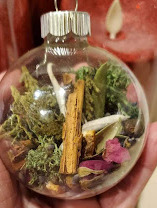
^ not made by me. I did make some really pretty protection ones but i forgot to take photos
Garlands
can be used as a form of protection. chant while you work on them :
I string protection into thee
as i work--so mote it be

^ not made by me
Ideas for homemade Yule garland:
orange slices, evergreen, cinnamon sticks, cranberries, popcorn, acorns, sunflower seeds, bay leaves, pinecones
depending on what you use, you can hang it on your fence afterwards to feed birds or squirrels. Always check each ingredient first.
(if using popcorn only use plain air-popped (or unpopped) without toppings, only let birds eat cinnamon if it is ceylon and not cassia)
#wiccalife#pagan wicca#pagan witch#paganism#wicca#wiccan#witch#witchcore#witchcraft#pagan#spell#spells#spellcraft#spellcasting#spellwork#magick#spirit work#baby witch#witch tips#ritual#christmas tree#christmas#holidays#xmas#festive#happy holidays#holiday#holiday season#pagan holidays#witches
15 notes
·
View notes
Text

HOW DOES CINNAMON REDUCE BELLY FAT?
In recent years, cinnamon has been spotlighted as a natural ingredient that can aid in weight loss, particularly in reducing stubborn belly fat. This common spice, beloved around the globe for its warm, sweet flavour, has been used in traditional medicine for centuries. Beyond its culinary uses, cinnamon is packed with compounds that offer various health benefits, including the potential to assist in weight management. But how does this aromatic spice work its magic on belly fat? Let's dive into the science behind cinnamon's fat-busting properties.
The Science of Cinnamon
Cinnamon is derived from the inner bark of trees from the Cinnamomum genus. There are two main types of cinnamon: Ceylon cinnamon (true cinnamon) and Cassia cinnamon. Most of the research on cinnamon's health benefits doesn't distinguish between the two, but both types contain health-promoting compounds.
Metabolic Boost
One of the critical ways cinnamon impacts weight loss is through its effect on metabolism. Cinnamon contains cinnamaldehyde, a compound that has been shown to activate thermogenesis. During thermogenesis, the body generates heat and energy by burning calories, which can lead to weight loss. By enhancing this process, cinnamon could help in reducing belly fat.
Blood Sugar Regulation
Cinnamon is well-known for its ability to regulate blood sugar levels. It improves insulin sensitivity and slows the breakdown of carbohydrates in the digestive tract, which can help prevent spikes in blood sugar and insulin levels after meals. This is crucial because high insulin levels can lead to fat storage, particularly in the abdominal area. Cinnamon might indirectly help control belly fat accumulation by managing blood sugar and insulin levels.
Anti-inflammatory and Antioxidant Properties
Chronic inflammation and oxidative stress have been linked to obesity and difficulty losing weight. Cinnamon is rich in antioxidants and has anti-inflammatory properties, which can help mitigate these conditions. Cinnamon could support overall weight loss by reducing inflammation and oxidative stress, including reducing belly fat.
Appetite and Cravings Control
Some studies suggest that cinnamon can help control appetite and cravings, possibly due to its influence on blood sugar levels. Stable blood sugar levels can lead to fewer cravings and a reduced appetite, making it easier to stick to a healthy diet and caloric deficit, essential for losing belly fat.
How to Incorporate Cinnamon into Your Diet
Incorporating cinnamon into your diet is relatively simple and can be pretty delicious. Here are a few ideas:
Sprinkle cinnamon on your morning oatmeal or cereal.
Add it to your coffee, tea, or smoothies.
Use it in baking and cooking for added flavour without extra calories.
However, it's important to note that simply adding cinnamon to your diet without making other healthy lifestyle changes is unlikely to lead to significant weight loss. A balanced diet and regular physical activity are essential to any effective weight loss plan.
Precautions and Recommendations
While cinnamon is generally safe for most people in culinary amounts, consuming it in large quantities or supplement form can lead to adverse effects, such as liver damage, especially with Cassia cinnamon, which contains higher amounts of coumarin. Pregnant women and individuals with liver conditions should be cautious and consult with a healthcare provider before adding enormous amounts of cinnamon to their diet or taking cinnamon supplements.
Conclusion
Cinnamon could be a valuable addition to a balanced diet and healthy lifestyle for those looking to reduce belly fat. Its ability to boost metabolism, regulate blood sugar, combat inflammation, and potentially control cravings offers a multifaceted approach to weight management. However, it's essential to maintain realistic expectations and understand that cinnamon is not a magic solution but a complementary aid in the journey toward better health and weight loss.
#usascriphelpersofficial#lose weight fast#weight loss drinks#weight loss treatment#weight loss motivation#weight loss tips#weight loss diet#weight loss journey
2 notes
·
View notes
Text
Cinnamon Tea: A Simple Treat
Who doesn’t love cinnamon? This tea is very easy for you to make in a short amount of time with some lovely flavors.
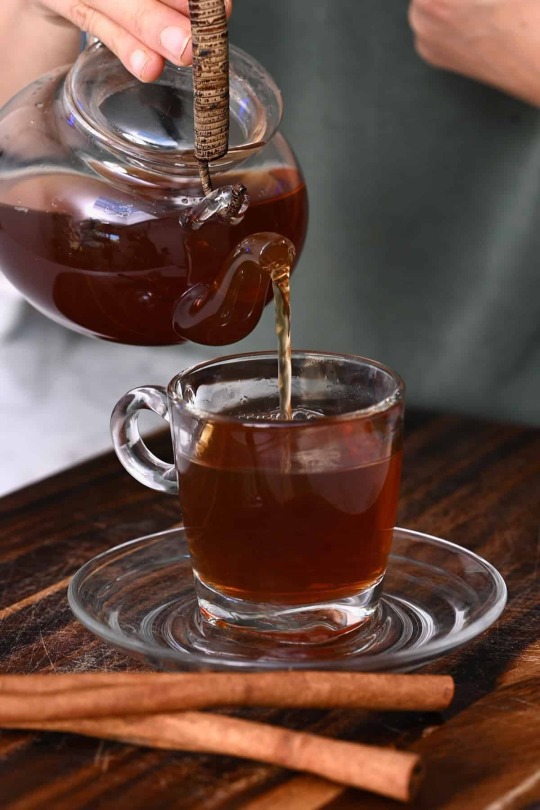
Ingredients:
3 cups water
4 cinnamon sticks, cassia or ceylon
Instructions:
In a saucepan over high heat, add the water and cinnamon sticks
Bring to a boil, cover and reduce heat to a low simmer
Simmer for 15 minutes then turn off the heat
Let it sit for 5 minutes longer, then remove the sticks, pour into mugs and enjoy! Feel free to add sugar and cream/milk to your personal tastes
11 notes
·
View notes
Text

INTERVIEW WITH THE VAMPIRE COCKTAILS
Claudia
A blood-red, bittersweet drink for a cunning, passionate young vampire.
2oz vodka
1oz cinnamon syrup*
.75oz Campari
.5oz fresh-squeezed lemon juice
8 raspberries (fresh or frozen)
Luxardo cherry for garnish
Combine all ingredients except cherry in a cocktail shaker with ice.
Shake well.
Strain into a chilled cocktail glass through a fine mesh strainer (to catch berry seeds). Discard seeds and pulp.
Garnish with a luxardo cherry on a pick.
*For cinnamon syrup:
In small saucepan, combine 1/2c sugar, 1/2c water, and about 2 small cassia cinnamon sticks OR 1 large ceylon cinnamon stick.
Heat on low heat until sugar dissolves completely.
Remove from heat, let cool completely with cinnamon sticks still infusing in the syrup.
Once cool, pour through mesh strainer to catch cinnamon bits, and discard cinnamon.
Keep refrigerated for up to about 4 weeks.
18 notes
·
View notes
Text
Black Tea F1
(got a big fizz when I gave it a stir - happy brew!)
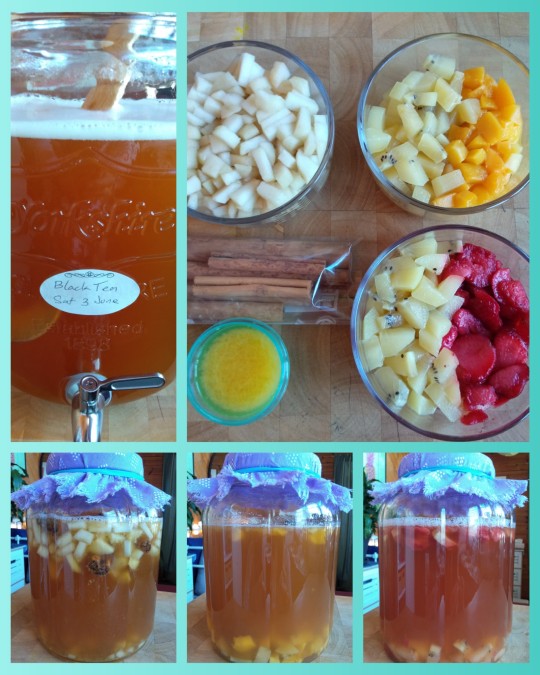
Pear (270g) Orange (60mL) Cinnamon sticks (48g)
Kiwi (150g) Mango (150)
Kiwi (150g) Strawberry (150)

Going through a bit of a golden kiwi phase right now, they're so tasty! So naturally I decide to give them a go in the booch - and it was a good call. Kiwi mango & kiwi strawberry - 👍👍
The pear is a winner too, tastes a lot like cider. But once again the cinnamon didn't come through, and I put so much in! 🤔
So I've decided the problem is the type of cinnamon. I've been using Ceylon or "true" cinnamon - which is generally considered to be better quality, but it has a more subtle flavour. Cassia is less fancy, but it's much more potent. So I'm thinking subtlety isn't the way to go here 😁
#kombucha home brewing#kombucha#home brewing#black tea f1#pear#orange#cinnamon#kiwi#mango#strawberry#main brew
2 notes
·
View notes
Text
Today's Ward Walk Salt
Leftover (culinary) sage burnings -helps cleanse old energy
Pulverized cinnamon sticks (technically cassia....) -adds power to a spell, burns out bad energies
Crushed bay leaves -sacred to Apollo, adds power to a spell, promotes intution (helps my wards judge what to let in vs keep out imo)
Black pepper -banishing
Coriander - longevity & prosperity
Coarse salt -cleansing, grounding, protecting
It smells like heaven btw.

#witchblr#witchcraft#witch#kitchen witch#hearth witch#magic#wards#protection magic#protection#black salt#ward walking
11 notes
·
View notes
Text


Apple tart with chili-cardamom caramel
A tart-sweet apple filling, spiced with Ceylon cinnamon and fennel, layered on a robust, flaky crust, then drizzled with a warming, aromatic clear caramel. The spices are subtle, creating a play of complementary flavors with no resounding winner.
Releasing liquid from the apples ahead of baking serves two purposes: creating a crust that is crisp all the way through; and forming a base for the caramel, marrying the flavors of the topping and the sauce.
Recipe under the cut!
Patreon | Paypal | Venmo
Ingredients
Makes one 12” x 12” tart. Serves 4-6.
For the dough:
1 cup (120g) all-purpose flour
1/4 tsp kosher salt
100g salted non-dairy margarine (stick form)
About 3 Tbsp cold water
For the topping:
1 1/2 baking apples, washed, cored, and thinly sliced
1/2-inch chunk Ceylon cinnamon, toasted and ground, or 1/2 tsp ground cinnamon (or substitute 1/4 tsp cassia cinnamon)
1/4 tsp fennel seeds, toasted and ground, or 1/4 tsp ground fennel
Pinch ground cloves
2 Tbsp vegetarian granulated sugar
Pinch salt
To assemble:
1/2 Tbsp non-dairy margarine, melted
For the caramel:
Liquid from draining apples
3 Tbsp sugar
3 green cardamom pods, crushed
1-2 dried red chilies, broken
With 1 chili, the sauce is to my taste warming without being detectably spicy. Increase chili as desired.
Instructions
For the dough:
1. Combine flour and salt in a mixing bowl. Cut cold margarine into an even dice with a sharp knife and coat in flour (or cut margarine into flour with a pastry cutter).
2. Add water, kneading dough against the sides of the bowl, until it just comes together. Cover and put in the refrigerator to chill.
For the topping:
1. Wash apples, core, and slice thinly. Toss with spices, salt, and sugar and put in a sieve over a bowl to drain. Leave for about an hour, stirring once, until apples have released several tablespoons of liquid.
To shape:
1. While the apples rest, roll out dough into a rough rectangle on a generously floured surface.
2. Fold the rectangle in three widthwise, like an envelope, and then in half widthwise to form a square.
3. Re-flour the surface, if necessary. Roll out dough again into a large square about 1/4” (1/2 cm) thick. Brush the surface of the dough with melted margarine.
To assemble:
1. Arrange apples over the dough so that they overlap slightly, leaving a 1-inch (2.5 cm) border on all sides.
2. Fold the edges over the apples and press down on the corners to seal.
3. Put in the freezer to chill while preparing the caramel.
For the caramel:
1. Pour the liquid from the apples into a saucepan (preferably one with a light-colored bottom) and heat on medium-low. Add sugar and stir to dissolve.
2. Add spices and heat on medium, without stirring, until simmering. If sugar starts to stick to the sides of the pan, brush it down with a wet pastry brush.
3. Continue to heat, gently moving the mixture back and forth with a rubber spatula if you notice the color changing unevenly, until caramel is a light amber color. This will probably happen quickly, so watch closely.
4. Remove from heat and carefully dunk the bottom of the pot in a bowl of cool water to halt further cooking.
To bake:
1. Preheat your oven to 400 °F (205 °C) with the rack in the center. Bake the apple tart for 50-60 minutes, until crust is golden brown and apples are tender.
2. Drizzle with caramel and serve hot.

88 notes
·
View notes
Text
Turkish Delights, Macun, and more Sweet Treats…
Beate Böhlendorf-Arslan, ANAMED Senior Fellow (2022–2023)

Fig. 1. Photo by author.
Turkish cuisine is versatile, and Turkish desserts are especially versatile. What is commonly known as “Anatolian sweets” in Europe, and called “Turkish honey” or “Turkish nougat,” is only one of the sugary offshoots of the delicious dessert in Turkey.
Almost every foreign visitor to Istanbul tries baklava, the delicacy made of thin layers of dough, nuts or pistachios, and sugar syrup, which comes in various shapes. By the way, fresh baklava with pistachios is especially delicious if served with a portion of damla sakız dondurma (mastic ice cream). On a particularly hot summer day, I recommend having it with a slice of kesme dondurma (“sliced ice cream”), an ice cream so firm that it must be eaten with a knife and fork.
Dessert lovers should also try other pastry specialties that come in a variety of shapes and flavors. The numerous and sometimes very old shops on Istiklal Caddesi sell specialties with flowery names such as bülbül yuvası (nightingale's nest), hanım göbeği (lady's belly), sütlü nuriye (nuriye—a woman's given name—with milk), vezir parmaği (vizier's finger) or kadayif. Commonly known and loved as a typical souvenir is Turkish delight (Fig. 1), lokum, made with nuts or fruit juice, or rose water. As delicious as these sweet treats are, Anatolian cuisine has much more to offer.
If you are looking for a more exotic souvenir, try the macun from Manisa, a soft candy that is a bit sticky on the palate but tastes very aromatic (Figs. 2 and 3). Manisa mesir paste is made out of spices mixed with various herbs such as cinnamon, black pepper, pimento, black cumin, mustard seed, aniseed, coriander, ginger, turmeric, coconut, fennel, cubeb, cassis, fructus, myroba, vanilla, piper longum, cardamon, galingale, fructus cassiae fistule, saffron, cumin, rose hip, myrrh, licorice, rhizoa zeoariae, lemon peel, orange peel, thistle seed, linseed, locust, opium poppy, stinging nettle, white pepper, grape seed, chaste berry seed, dried rosemary, erica leaf, melissa, fructus myrobalani nigri, and hibiscus. The consumption of these candies is said to have a healing effect. According to legend, the wife of the Ottoman sultan Yavuz Selim, Hafsa Sultan, fell ill during her stay in Manisa. As there was no cure, Merkez Effendi, the head of the madrasa of the Sultan's mosque, prepared a paste of herbs and spices. After eating this paste, Hafsa Sultan recovered. Following her recovery, she ordered this paste to be spread from the minarets of the sultan's mosque. This tradition has been maintained in Manisa since 1539.

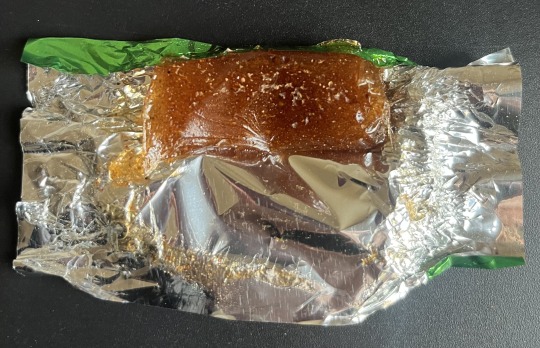
Fig. 2- 3 Photo by author.
The traditional lollipops that can be bought fresh in the streets of Istanbul, but also in villages like Behram/Assos and many other places in Turkey, are prepared in a similar way. However, they do not contain a variety of herbs and spices but only fruit juices or tree resin (damla sakiz or mastic) and a lot of sugar (Fig. 4). The seller dips a wooden stick into the sugar mass and turns the stick several times so that the gluey mass wraps around the stick. Now the lollipop is ready!
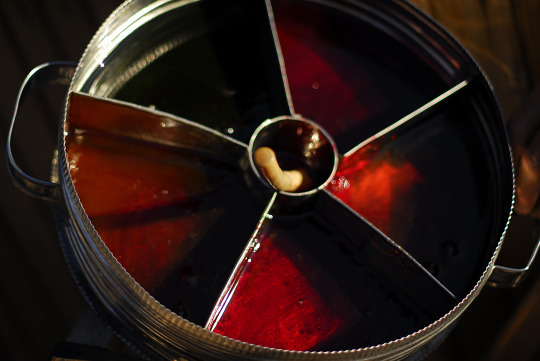
Fig. 4. Assos excavation archive, Aykan Özener.
Other than these sweet souvenirs and shelf-stable desserts, Turkish cuisine has equally tasty creamy desserts to offer that you should not miss out on.
Milk dishes are especially delicious. Even something as common as rice pudding (sütlaç) has a special Turkish twist to it. It is prepared with regular rice, not the round-grain rice used in other countries. Turkish rice pudding is not firm but rather creamy. Most importantly, it is placed in the oven in a second step after cooking, causing the top layer of milk to caramelize (Fig. 5). Tasting it is highly recommended!
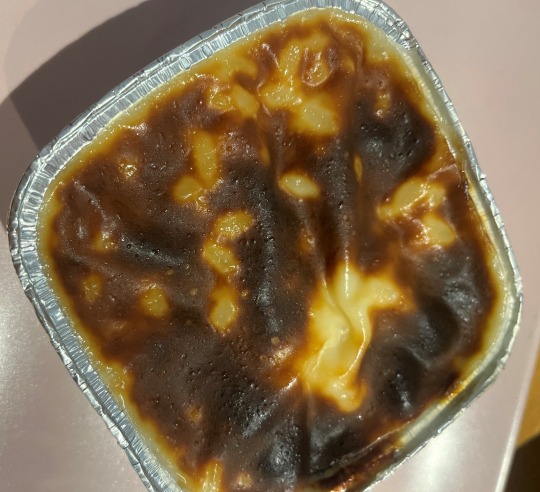
Fig. 5. Photo by author.
The more adventurous Istanbul travelers should definitely try tavuk göğüsü (a dessert literally called “chicken breast”). Tavuk göğüsü consists of finely pureed chicken breast cooked in sweetened milk and rice flour as a starch to thicken the milk (Fig. 6). The dessert is usually served with cinnamon. Sometimes it is grilled in the oven, resulting in a caramelized top and tasting almost more delicious than the unbaked version (Fig. 7). This preparation is called kazandibi (“bottom of the pot”). I often had the pleasure of treating foreign visitors who were not vegetarians or vegans to a tavuk göğüsü and then having them guess what the dessert was after the meal. Nobody had any idea that there was meat in the dessert!


Fig. 6-7 wikimedia
Regarding possible historic roots, tavuk göğüsü bears no resemblance to the pullus tractogalatus (chicken in milk porridge) described by the Roman cook Apicius in the 3rd or 4th century CE. In this dish, the chicken (or fish) was first cooked in white wine and olive oil, boned, and then the mouthfuls of chopped meat were doused in a porridge made from chicken broth, milk, honey, and grape juice. It is possible that Europeans brought the white meat and milk dish back to Europe during the Crusades, having learned it from the Arabs. A similar dish to tavuk göğüsü, blanc mange, was eaten by nobles and wealthy people in the European Middle Ages. In the oldest German cookbook from around 1350, the Buoch von guoter spise, there is a recipe that calls for rice ground into flour, milk, and a chicken breast to be cooked together. Other recipes used fish instead of chicken. For the nobility, however, blanc mange was not a dessert but a main dish.
Another famous dessert, aşure, has different roots. According to the legend, when Noah saw the land again with his ark, he cooked a pudding from the remaining supplies, namely cereals and dried fruits. In the ancient Greek pantheon, wheat symbolized the earth goddess Demeter, pomegranates represented her daughter Persephone, queen of the underworld, almonds were sacred to Aphrodite, and raisins were sacred to the god Dionysus. Interestingly, the eastern Romans, as inhabitants of Byzantium, also knew of such a pudding, which they called kollyba (or kolivia). It is said that kollyba was the food that the Virgin Mary was fed as a child in the temple by angels from heaven, as depicted on a wall mosaic in the Chora Church in Istanbul (fig. 8). There are different recipes to prepare kollyba, whose main ingredient is boiled wheat mixed with various dried fruits. It is served as a common Lenten food and was therefore commonly eaten in monasteries. Kollyba was also prepared as a dish for the commemoration of the dead. For the Greeks, aşure is also known as barvara (Βαρβάρα), named after the feast of Saint Barbara that is celebrated on the 4th of December. During this festival, it is cooked and shared with neighbors.

Fig. 8. Photo by author.
The ingredients for aşure (but also for varvara or kollyba) are wheat grains, white beans, and chickpeas, and sometimes also rice and barley, that are cooked until soft. After draining, the aşure is sweetened with honey or sugar. In addition, aşure also contains some or all of the following: sesame seeds, almonds, hazelnuts, walnuts, pine nuts, cinnamon, sugar, pekmez, pomegranate seeds, raisins, sultanas, dried apricots, figs, dates, grated orange or lemon peel, cardamom, cloves, black cumin, mastic, rose water, or even anise (Fig. 9). Every family in Turkey (as well as in Greece, the Balkans, and the Middle East) has its own recipe, but the one thing they have in common is that they always make a big pot to share with others. So, if you have a chance to try a homemade aşure, do not miss out on it. Otherwise, try my favorite Anatolian sweet at one of the many muhallebecisi (pudding maker) in Istanbul!
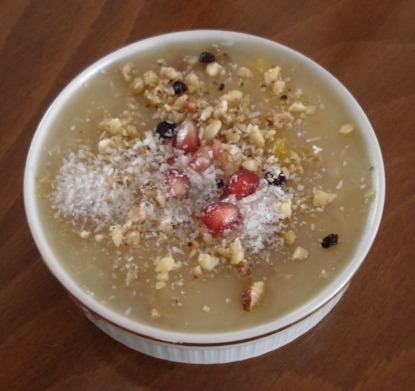
Fig. 9. wikimedia
Afiyet olsun!
------------------------------------------------------------------------------------------------------------------------------------------------
Further readings/bibliography:
Apicius, De re coquiniaria
Anagnostiakis, Ilias, ed. Flavours and Delights. Tastes and Pleasures of Ancient and Byzantine Cuisine. Athens: Armos, 2013.
Baş, Nejla. Mutfağımızdaki Tehlike. Istanbul: Ser Kitap, 2019.
Papanikola-Bakirtzi, Dimitri, ed. Byzantinōn diatrophē kai mageireiai/Food and Cooking in Byzantium. Athens: Museum of Byzntine Culture, 2005.
Waksman, Sylvie Y., ed. Multidisciplinary Approaches to Food and Foodways in the Medieval Eastern Mediterranean. Lyon: MOM Editions, 2020.
www.kulturportali.gov.tr/turkiye/genel/neyenir
de.wikipedia.org/wiki/Mandelsulz
2 notes
·
View notes
Text
organization isn't licensed by the Better Business Department.berbaprime
supply, situating it inside a sensible to-excessive cost range contrasted with other comparable enhancements available.
Notoriety and client surveys
Doesn't stick out
doctors" and the "world's most memorable clinically tried diabetes supplement." Made by clinical drug specialist Charles Liu, berbaprime control was motivated by Liu's own
experience with his mom's diabetes battles and his perceptions of patients depending on various meds just to deal with the side effects brought about by their diabetesGinseng root extricate contains dynamic parts called ginsenosides that can settle insulin and glucagon to keep up with ideal blood glucose levels. Green tea has been connected to diminished fasting glucose levels and A1C levels, as well as lower fasting insulin levels in individuals with diabetes, making it a
possible guide in overseeing glucose levels.
Lutein is found in green verdant vegetables like spinach, kale and yellow carrots, and a characteristic cell reinforcement upgrades eye capability. Lutein
supplementation might diminish the probability of creating diabetes by forestalling glucose issues related with low blood levels of lutein or different carotenoids.
Cassia bark remove is like cinnamon. It contains synthetic compounds that further develop insulin awareness and add to glucose control.
As to aftereffects, it's essential to note thatberbaprime control isn't suggested for pregnant or nursing ladies. It's smart to converse with a specialist previously
as with any enhancement. In any case, it's disturbing that there are no recorded aftereffects (particularly given
The suggested measurements forberbaprime control is two cases with a feast one time each day, giving simplicity and comfort to clients. The expense ofberbaprime control is $37.99 for a 30-day
Simple routine, normal valuing
Not much data about producer accessible on the web
berbaprime control is fabricated by Omni One LLC. Tragically, we were unable to find a lot of data about this organization online other than that its President is Charles Liu. The
All purchases are final conceivable
Sadly, you can't return berbaprime control on the off chance that it doesn't work for you, so you will be facing a little monetary challenge assuming that you truly do choose to give it a shot. Nonetheless, the
maker offers a discount or substitution in the event that your request shows up harmed.
1 note
·
View note
Text
Types of Cinnamon Which Can Be Used For Cooking

Ground cinnamon is the most common cinnamon, sold as a fine powder with a warm, spicy aroma. With its mellow flavor, it's great for the holidays and all day long. The cinnamon is among the best known and most widely used spices in the world, complementing foods and beverages. The use of cinnamon as a flavoring agent has been around for centuries, and with good reason: it's delicious!
Want to add a little something special to your spice cupboard? You might be surprised to learn that not all cinnamon sticks are created equal.
Types of Cinnamon
There are four main species of cinnamon cultivated for commercial use.
Cinnamomum verum (Ceylon Cinnamon)
This cinnamon is called true cinnamon, Ceylon cinnamon, or soft cinnamon because it's native to Sri Lanka and Southern India. It's also sometimes called "Mexican cinnamon" because it grows widely in Mexico and parts of Africa. This is a versatile variety with a sweet, spicy flavor that's ideal for baked goods.
Cinnamomum burmannii (Korintje Cinnamon)
Known as Korintje cinnamon, Vietnamese cinnamon is a popular variation of the true cinnamon. It is regarded as milder than cassia and is less complex. This makes it a good candidate for cooking because it won't overpower delicate flavors.
Cinnamomum cassia (Saigon Cinnamon)
Saigon cinnamon is mildly spicy and sweet, not particularly spicy compared to other types of cinnamon. It originates from Southeast Asia and the flavor profile is more similar to Cassia than Ceylon cinnamon. This version of cinnamon is best for general use.
Cinnamomum loureiroi (Royal Cinnamon)
Royal cinnamon is a type of cinnamon that looks and tastes different from the common variety. It comes from central Vietnam and is sometimes called Saigon cinnamon or Vietnamese cinnamon. This cinnamon is harder to find on grocery store shelves, but spice purveyors often sell it.
Cooking with Cinnamon
Cinnamon is used in both sweet and savory dishes. Both Ceylon Cinnamon (Cinnamomum verum) and Cassia Cinnamon (Cinnamomum cassia) are commonly used. Using Cinnamomum Verum in savory dishes, such as Indian curries, or on meats like chicken, since it lends an earthy flavor without being overpowering.
If you are using new cinnamon, the most reliable way to test out a new cinnamon is to make a quick cup of cinnamon tea. Take a teaspoon, pour over hot water and let it infuse. The flavor should be sweet and spicy. If it's not, then this brand is not worth using or you'll need to use more in order to get a similar intensity of flavor.
Whether you're baking a loaf of bread or a batch of cinnamon buns, the right cinnamon can make all the difference. Saigon cinnamon or Royal cinnamon, which he finds to be amazing in cinnamon buns and snicker doodles and really any cinnamon dessert like oatmeal cookies or a variety of coffee cakes.
If you plan on cooking for a long time and don't want to waste money then remember to replace your spices after a few months because they eventually lose their pungency.
Red Ape Cinnamon is proud to be one of the few vendors offering genuine Cassia and Ceylon cinnamon; we take pride in providing heavy metal test cinnamon. Experts test our product for safety and quality before being supplied to our store. To know more visit our website now.
0 notes
Text
Buy Premium Quality Cassia Stick and Enhance Your Dishes with Quality Spice. | Milleton agro
In the sector of culinary arts, each chef is familiar with the paramount significance of the use of satisfactory substances. Among the plethora of spices that improve our dishes, cassia sticks out for its unique aroma and taste. Milleton Agro Pvt. Ltd, a trusted call in the realm of agro-product exports, offers premium pleasant cassia sticks that are sure to enhance the flavor and aroma of your culinary creations.
For over 25 years, they were a beacon of settlement and reliability in the agro-product export organization. Specializing in a large selection of products which includes spices, pulses, and dried fruits, the agency prides itself on catering to the diverse goals of its customers. With a determination to sourcing from the finest farms and plantations, they ensure that every product meets stringent outstanding standards, and its cassia sticks are not any exception.
Cassia sticks, also known as Chinese cinnamon, are derived from the bark of the cassia tree. Distinct from actual cinnamon, cassia boasts a stronger, extra pungent taste profile, making it a favorite amongst chefs and home cooks alike. Its wealthy aroma and heat, highly spiced taste lend intensity and complexity to each candy and savory dish, earning it an everlasting region in kitchens around the world.
Whether you are crafting a comforting bowl of cinnamon-infused oatmeal, an aromatic biryani, or a decadent batch of cinnamon rolls, the satisfaction of your cassia stick could make all the difference. Cassia sticks are meticulously sourced and processed to keep their herbal oils and flavors, making sure that every stick supplies the most aroma and taste.
One of the key elements that units their cassia sticks aside is the organization's unwavering dedication to high-quality and sustainability. With a crew of over one hundred experts committed to dealing with their agricultural merchandise, they adhere to sustainable farming practices to minimize environmental impact and promote lengthy-time ecological balance. By deciding on cassia sticks, you now not handiest increase your culinary creations but additionally help ethical and responsible sourcing practices.
In addition to its cassia sticks, they also offer a comprehensive variety of agro-products, along with a variety of grains such as rice, wheat, and corn. Whether you are stocking your pantry or sourcing elements to your eating place, Milleton Agro is your one-prevent vacation spot for premium excellent agro-products that meet the highest requirements of excellence.
To enjoy the difference that top class best cassia sticks can make for your dishes, look no further than Milleton Agro Pvt. Ltd. Contact them today to place your order and embark on a culinary journey filled with extraordinary taste and aroma. With their dedication to satisfactory and purchaser pride, you may trust that you're getting nothing however pleasant in your kitchen.
0 notes